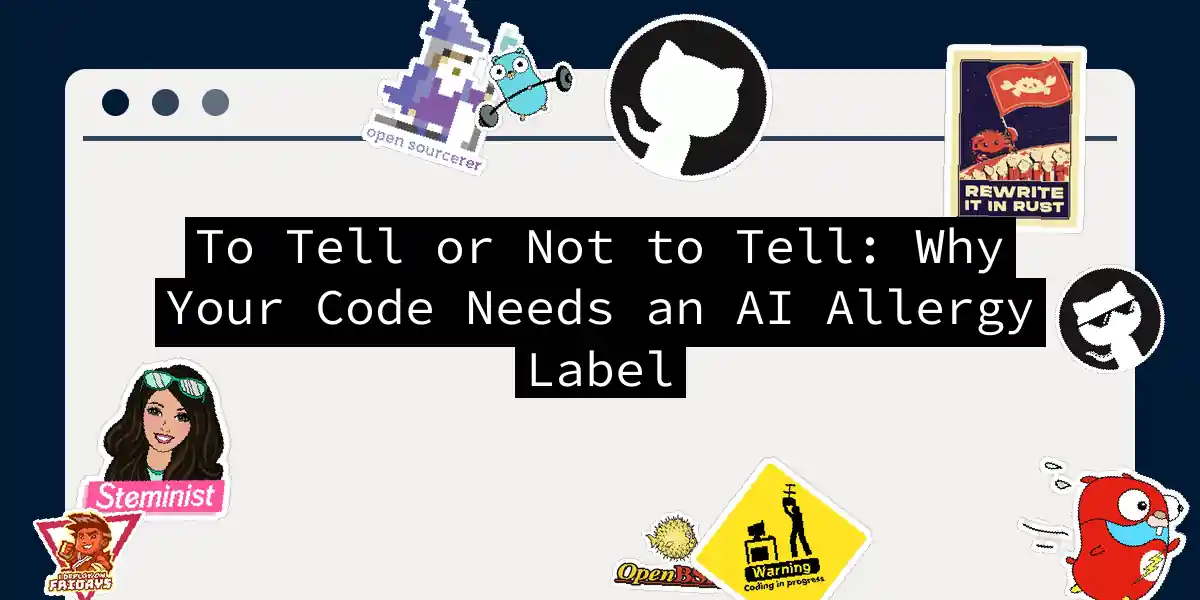Picture this: You’re on a first date with someone who claims to be “100% organic, handcrafted artisanal human.” Three margaritas later, they casually mention they’re 37% titanium. That’s modern software development with undisclosed AI - a magic black box that might turn into a pumpkin at midnight. Let’s slice this silicon cake layer by layer.
The Elephant in the Server Room
We’ve all been there - staring at code that works suspiciously well. Like finding a perfectly shaped avocado at the grocery store, it feels unnatural. Recent data shows 88% of developers believe AI tool disclosure is necessary. But how do we implement this without turning documentation into a Turing test?
The Ethical Obligation Tango
When your CI/CD pipeline includes more artificial neurons than organic ones, disclosure becomes the digital equivalent of ingredient lists on snack packages. As MIT researchers note: “Transparency builds trust and prevents AI systems from becoming modern-day snake oil salesmen”. Consider this Python snippet that should make any developer’s skin crawl:
def is_ai_generated(code):
suspicious_patterns = [
"import tensorflow",
"AutoGPT",
"from openai import",
"# TODO: Remove magic numbers"
]
return any(pattern in code for pattern in suspicious_patterns)
if is_ai_generated(my_code):
print("⚠️ Warning: May contain traces of artificial intelligence")
The Business Case for Truth Serum
Companies like IBM and Microsoft are leading the charge with RAI (Responsible AI) frameworks. Their KPIs now include metrics like:
- Percentage of AI-generated code reviewed
- Bias detection pass rates
- Number of developers who’ve watched Terminator Here’s how to implement a basic disclosure badge in your docs:
function generateAIDisclosure(confidenceLevel) {
const warningLevel = confidenceLevel > 0.75 ?
'🚨 CYBER-CARBONARA DETECTED 🚨' :
'🤖 Contains 100% Artificial Intelligence';
return `<div class="disclosure-banner">${warningLevel}<br>
This code may contain algorithms trained on:<br>
- 42 million cat videos<br>
- Every Stack Overflow answer since 2008<br>
- The collected works of Nietzsche (for dramatic effect)</div>`;
}
The Counterargument Carnival
“But wait!” cries the over-caffeinated startup founder, “Disclosure is like telling competitors our secret sauce recipe!” To which I say: Your “secret sauce” is probably just ketchup and existential dread mixed in a Kubernetes cluster. The D&O Diary notes that even non-tech companies need AI disclosures, because nothing says “trustworthy” like a toaster that explains its machine learning models while burning your bread.
The Developer’s Field Guide
When in doubt, use the TACOS framework (Transparency About Code Origin System):
- Document AI usage in your README.md
- Add IDE plugins that flag AI-generated blocks
- Implement automated code review checks
- Train juniors to recognize artificial code smells
- Host mandatory “AI Ethics Happy Hours” (margaritas optional)
# Simple pre-commit hook example
#!/bin/sh
grep -rnw . -e 'Generated by AI'
if [ $? -eq 0 ]; then
echo "AI content detected! Update documentation first."
exit 1
fi
The Future Is Transparent (Like Jell-O)
As Kontent.ai suggests, we’re moving towards standardized disclosure labels - the nutritional facts of programming. Will we see “100% Human-Crafted Code” certifications? “AI-Free” badges? Maybe even artisanal code farmers markets? In the end, disclosure isn’t about fear - it’s about respecting users enough to say: “This app contains 0.3% artificial flavoring. We promise it won’t try to overthrow humanity (terms and conditions apply).” Now if you’ll excuse me, I need to go check if this article was written by ChatGPT. Wait, how would I even know? [Dramatic chipmunk exit music plays]
